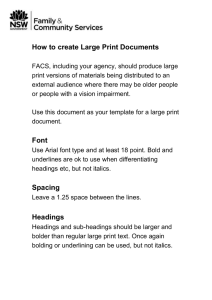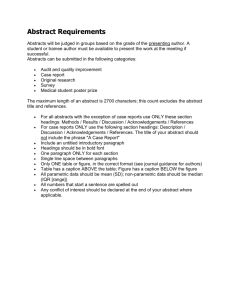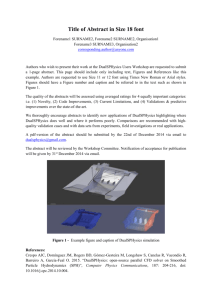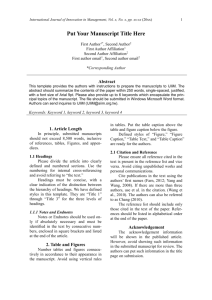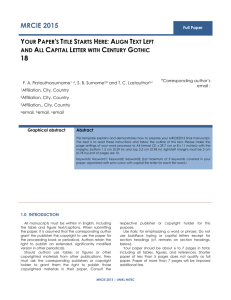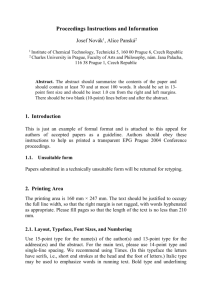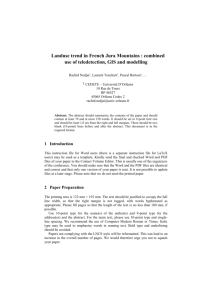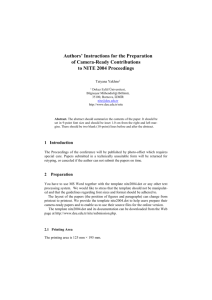Abstract Formatting Guide: Academic Research
advertisement
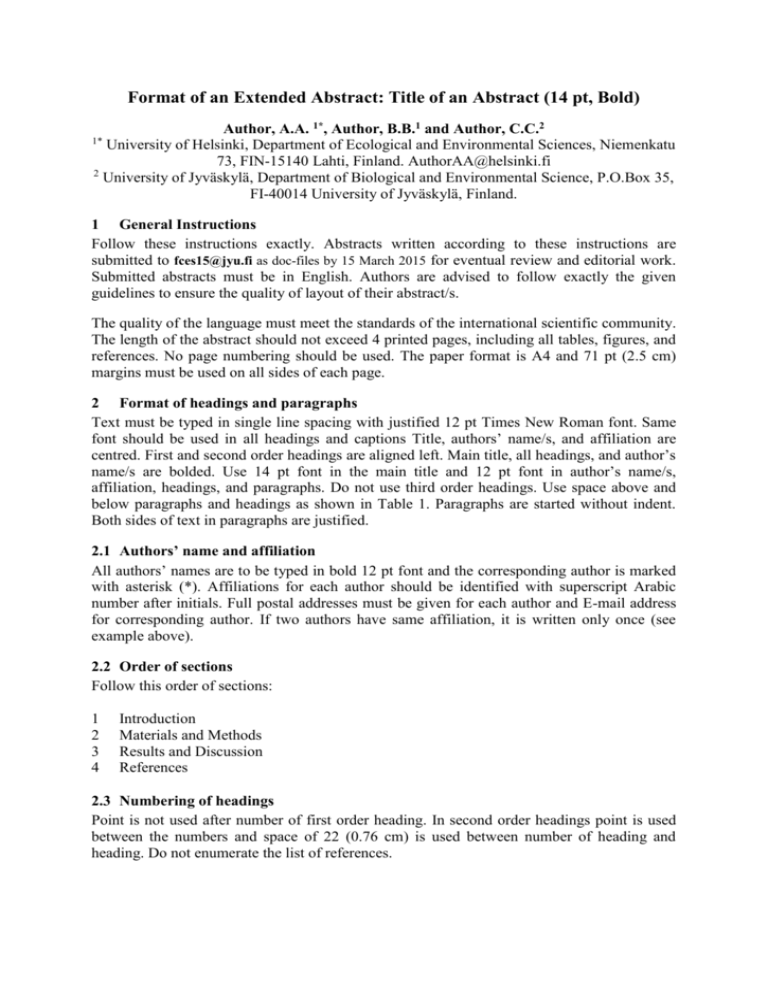
Format of an Extended Abstract: Title of an Abstract (14 pt, Bold) Author, A.A. 1*, Author, B.B.1 and Author, C.C.2 University of Helsinki, Department of Ecological and Environmental Sciences, Niemenkatu 73, FIN-15140 Lahti, Finland. AuthorAA@helsinki.fi 2 University of Jyväskylä, Department of Biological and Environmental Science, P.O.Box 35, FI-40014 University of Jyväskylä, Finland. 1* 1 General Instructions Follow these instructions exactly. Abstracts written according to these instructions are submitted to fces15@jyu.fi as doc-files by 15 March 2015 for eventual review and editorial work. Submitted abstracts must be in English. Authors are advised to follow exactly the given guidelines to ensure the quality of layout of their abstract/s. The quality of the language must meet the standards of the international scientific community. The length of the abstract should not exceed 4 printed pages, including all tables, figures, and references. No page numbering should be used. The paper format is A4 and 71 pt (2.5 cm) margins must be used on all sides of each page. 2 Format of headings and paragraphs Text must be typed in single line spacing with justified 12 pt Times New Roman font. Same font should be used in all headings and captions Title, authors’ name/s, and affiliation are centred. First and second order headings are aligned left. Main title, all headings, and author’s name/s are bolded. Use 14 pt font in the main title and 12 pt font in author’s name/s, affiliation, headings, and paragraphs. Do not use third order headings. Use space above and below paragraphs and headings as shown in Table 1. Paragraphs are started without indent. Both sides of text in paragraphs are justified. 2.1 Authors’ name and affiliation All authors’ names are to be typed in bold 12 pt font and the corresponding author is marked with asterisk (*). Affiliations for each author should be identified with superscript Arabic number after initials. Full postal addresses must be given for each author and E-mail address for corresponding author. If two authors have same affiliation, it is written only once (see example above). 2.2 Order of sections Follow this order of sections: 1 2 3 4 Introduction Materials and Methods Results and Discussion References 2.3 Numbering of headings Point is not used after number of first order heading. In second order headings point is used between the numbers and space of 22 (0.76 cm) is used between number of heading and heading. Do not enumerate the list of references. Table 1. Format of titles, figures, tables, and lists. Space to be left before and after items is shown in points. Note that spaces are never greater than 12 points. Three points equals 0.11 cm and 12 pt equals 0.42 cm. Above (pt) Below (pt) Main Title 3 12 Author 12 0 Affiliation 0 12 Headings 12 3 Paragraph 3 12 Figure/Table 0 (12) 12 List 12 12 Equations 12 12 References 3 12 3 Tables, Figures, and Equations Tables and figures should be imported into text in a complete form, and they should be comprehensible without reference to the text. It is preferred that figures are inserted on the top of the page, except in the first page where they should be inserted on the bottom of the page. When a figure is on the top of the page, it begins right after marginal and there is space of 12 pt (0.42 cm) after the caption. There is no space between the figure and its caption. If a figure is placed on the bottom of the first page, there is 12 pt (0.42 cm) of space before it, and the figure ends to marginal. If a figure is placed in the middle of the text (not recommended), space of 12 pt (0.42 cm) before figure and after its caption should be used. Same guidelines are used with tables with one exception: caption of table is typed above the table and caption of figure is typed below the figure. Figures and tables are centred and no space is used between figure/table and its caption. Both captions must be enumerated in the order they appear in the text (Figure 1.). In caption hanging indent of 1.9 cm is used and caption is justified (Figure 1.). Note that figures are printed in black and white. Do not use vertical lines in tables or space bars to separate columns. Do not use fill in-colours or background colours in figures. If possible, avoid horizontal lines in figures. Ensure that all text in figures uses the same font (preferably Times New Roman), with strict minimum size of 10 pt. Examples of table and figure are provided (Table 1, Figure 1). Inline equations like a2+b3=c4 are written in italic. All other equations are inserted into text as an object and enumerated in the order they appear in the text. Equations are centered and the number of equation is placed on the right side in parenthesis. 4 Reference Style References are cited in the text as follows: author name/s and year of the publication in parentheses: One author: (Miller 2003) Two authors: (Miller & Thomas 1995) Three or more authors (Miller et al. 1996) If there is more than one listing of the same author and year, use a, b, c, etc. (Miller 1993a). The reference list should be alphabetical. If there are several works by one author, the following order should be used: Concentration (µg/l) 100 treatment A 80 treatment B 60 40 20 0 0 5 10 15 20 25 30 Incubation time (days) Figure 1. Example of a figure. Use 12 pt font in figure and table captions. Justify both sides of caption and use 1.9 cm hanging indent. Type words “figure” and “table” and their number with bold lower case letters. Note that because different shades of grey may not be distinguished well in the printed version you should use different filling patterns. All publications by the same author alone, ordered chronologically by year of publication. All publications by the author with a co-author, ordered alphabetically by co-author. All publications by the same author with several co-authors, ordered chronologically by year of publication. All references listed must be cited, and all cited references must be included in the reference list. Example of the reference list is given below. References Beveridge, W.I.B. 1964. The Art of Scientific Investigation, Mercury Books, London, 178 pp. Chiavari, G., Torsi, G., Fabbri, D. and Galletti, G.C. 1994. Comparative study of humic substances in soil using pyrolytic technique and other conventional chromatographic methods. Analyst 119:1141-1150. Peuravuori, J. and Pihlaja, K. 1999. Structural characterisation of humic substances. In Keskitalo, J. and Eloranta, P. (eds.) Limnology of Humic Waters, Backhuys Publishers, Leiden, 22-34.
